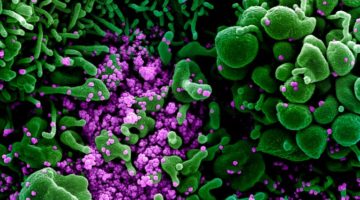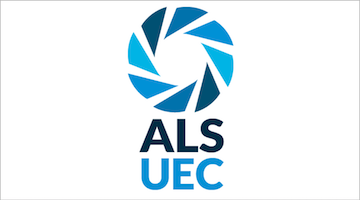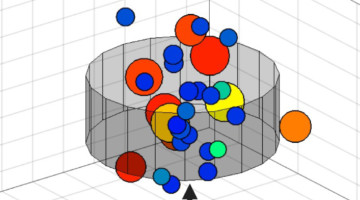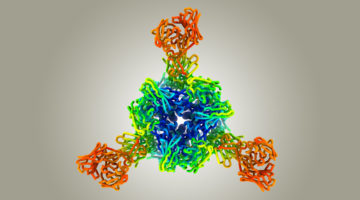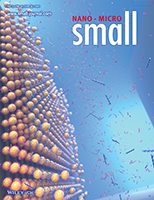A one-atom-thin 2D magnet that operates at room temperature could lead to new applications in computing and electronics—such as high-density, compact spintronic memory devices—and new tools for the study of quantum physics. X-ray experiments at the ALS characterized the material’s magnetic parameters under high temperature. Read more »
All News & Updates
Deconstructing the Infectious Machinery of the SARS-CoV-2 Virus
Scientists collaborated to model the complex protein responsible for SARS-CoV-2 replication, revealing its potential weak spots for drug development. The investigation hinged on data collected from many advanced imaging techniques, including small-angle x-ray scattering (SAXS), crystallography, and small-angle neutron scattering (SANS). Read more »
Survey on Remote Access
The ALS and the Users’ Executive Committee would like to better understand the impact this past year’s restrictions had on the user community as well as seek suggestions on possible improvements that would facilitate future beamtime. We request your input on this remote access survey by July 30. Read more »
Alpha N’Diaye, Research Scientist
Alpha N’Diaye first came to Berkeley Lab as a postdoc, but his interest in Berkeley was piqued far earlier. Find out what inspired teenage Alpha, and what keeps him here to this day. Read more »
Mineral Microstructures Shed Light on Planet-Scale Dynamics
To explore what happens to minerals under the extreme conditions in Earth’s mantle, researchers developed an x-ray technique that bridges the gap between methods that reveal bulk properties and those that focus on individual crystals. Use of the technique has shed light on the dynamics of tectonic-plate subduction in Earth’s lower mantle. Read more »
Register for the 2021 User Meeting (August 10–13)
This year’s User Meeting features, for the first time, a Nobel panel (and Q&A) with Ada Yonath and Stanley Whittingham. Bookmark workshops and tutorials that interest you so that the organizers know how many participants to expect. Remember: the student poster competition and general poster session are first come, first served! Read more »
Congratulations and Thank You to Our 2021 Retirees!
Thank you to Sue Bailey, Pat Casey, Susan James, Dave Richardson, Jackie Scoggins, Doug Taube, and Scott Taylor for your innumerable contributions and many years of service! Read more »
Tuning Semimetallicity Using Thin Films and Interfaces
With support from ALS data, scientists gained new insight into a semimetal’s unusual electronic behavior. The work lays out a basic strategy for engineering the band structures of semimetallic compounds using dimensional confinement and reveals a new way of creating two-dimensional electron/hole gases by exploiting interfacial bonding. Read more »![]()
![]()
Researchers Set Sights on Another COVID-19 Target
Early in the COVID-19 pandemic, it was quickly established that the receptor binding domain (RBD) of the SARS-CoV-2 spike protein is a prime target for neutralizing antibodies. Now, scientists have found a second region of the spike protein that is targeted by dozens of antibodies, some of which exhibit ultrapotent neutralizing activity. Read more »
Rapid In Situ Ligand-Exchange Process Used to Prepare 3D PbSe Nanocrystal Superlattice Infrared Photodetectors
A new strategy for retaining long-range order during ligand exchange of nanocrystal superlattices is used to construct PbSe infrared photodetectors. The ordered photodetectors have a 16× higher responsivity and 2× faster response time compared to disordered ones. Read more »
- « Previous Page
- 1
- …
- 49
- 50
- 51
- 52
- 53
- …
- 139
- Next Page »

